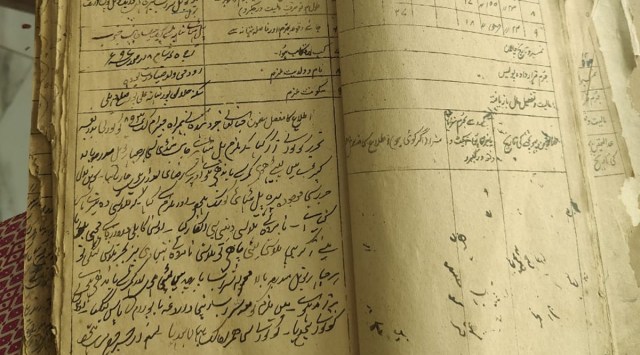Oranges, pyjamas and kulfi… Police’s earliest FIRs offer a glimpse of life & crime in Delhi
The case, dating back to 1900, is among the earliest FIRs that have been uploaded on the Delhi Police's website as part of a digitisation effort.
 One of the FIRs that have been translated and digitised. (Express Photo)
One of the FIRs that have been translated and digitised. (Express Photo) It was a cold case of deceit. Shiva had asked his relative Fateh to look for a suitable match for him. Fateh and his associate took Rs 20 from Shiva, promising to get him married to a 16-year-old girl. On the day of the wedding, Shiva realised to his horror that the bride was an old woman, who fled from the scene. Shiva, poorer by a bride and Rs 20, filed a case.
The case, dating back to 1900, is among the earliest FIRs that have been uploaded on the Delhi Police’s website as part of a digitisation effort.
So far, 29 such “antique” FIRs of crimes reported between 1861 and 1900 have been uploaded on the website, most of them related to robberies – 104 pigeons, 110 goats stolen from near a lake, a pair of pyjamas, 11 oranges, a liquor bottle, a pony, bedsheet, a single plate, even a kulfi.
An FIR lodged on October 1, 1899 in North Delhi’s Alipur reads that a man named Tori uprooted a Keekar tree on a government road and hid it in his farm. He was later arrested and asked to pay a fine of Rs 5.
“In the 1800s, most arrests and even convictions were done within days of the incident. Those were simpler times when even thefts of oranges, pigeons and pyjamas used to be a big deal. Today, we have thousands of cases, some of which are complex and take time to investigate. The conviction also takes longer because of the high pendency of cases in courts,” said ACP Rajender Singh Kalkal, who worked on preserving and deciphering some of the FIRs.
One of the high-profile cases is related to a theft in New Delhi’s Imperial Hotel in 1897. The FIR states that a cook from the hotel came to Sabzi Mandi police station with a “complaint letter in English” stating that the thieves entered a room in the hotel and stole a pack of cigars and a liquor bottle. The hotel announced a reward of Rs 10 to nab the accused, but that was the last anyone heard of the thieves or the cigars and liquor bottle. The case could never be solved.
The research and preservation of the FIRs have been carried out by the Delhi Police’s Perception Management and Media Cell team with the “dual purpose of making people aware of Delhi Police’s history and learning policing from older times”.
Delhi Police spokesperson DCP Suman Nalwa said, “We have now uploaded information about antique FIRs for everyone to learn from. To make the process easier and fun, all the FIRs have been translated from Urdu to Hindi and each document comes with animated caricatures of the incidents.”
Deciphering the FIRs wasn’t easy, said DCP Nalwa. “All these FIRs were written in Shikasta Urdu, which is not commonly understood by most Urdu-speaking people. We had to call in scholars and maulvis to help us learn the language and translate the FIRs,” he added.
While policing started in Delhi, Punjab and other northern states in the 1200s, an organised form of policing came into place after the first war of Independence in 1857. The Indian Police Act started in 1861 with five police stations in Delhi – Mehrauli, Sabzi Mandi, Nangloi, Kotwali and Sadar Bazaar.
ACP Kalkal, whose team is in charge of research and preservation of artefacts at the Delhi Police Museum in Kingsway Camp, had carefully preserved some of the old FIRs. Kalkal said he studied hundreds of FIRs and found that the format of the complaints has largely remained the same over the last 200 years.
“Just like the FIRs of today, the older FIRs have columns detailing details of the complainant, FIR number, sections and suspects. The only substantial difference is in the last part of the FIR, which details the complaint. Earlier, the police would write a brief of the incident. Nowadays, we take the complainant’s full version and use it in the FIR,” said Kalkal.
ACP Kalkal said most of the old FIRs are intact with the writing still legible and the paper in good condition. In a few cases, police also found the binders/copies used to store the FIRs.
“Since the paper and binders were made of natural and indigenous material, it was easy to preserve the FIRs. We have been doing this for almost 20 years at the Delhi Police museum. Now, we are taking the FIRs and translating them” said ACP Kalkal.
One of the FIRs registered at Sabzi Mandi police station, is from February 16, 1891, and details the theft of 11 oranges.
The FIR reads, “The accused Ram Baksh, along with 4-5 associates, stole 11 oranges from Ram Prasad’s farm.” On February 23, 1891, the accused were caught and sentenced to one-month rigorous punishment.







